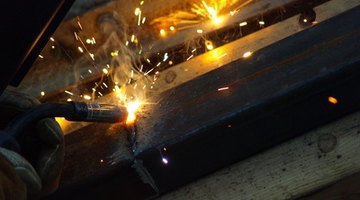The Effect of Welding on High Carbon Steel
Table of Contents
High-carbon steels are decidedly more difficult to weld than low- or medium-carbon steels. However, a variety of measures are available to ensure a strong weld.

Steel Alloys
Steel is an alloy, or metallic mixture, containing primarily iron. A variety of other metals, such as carbon, are used to promote certain properties in the alloy. Carbon has a strengthening effect when added to iron.
Carbon Rating
There are different types of steel available, including several varieties of carbon steel. Low-carbon steel contains a maximum concentration of 0.3 percent carbon, while high-carbon steel contains a maximum concentration of 1 percent carbon.
Carbon in Steel
Carbon strengthens steel, but also reduces its ductility, or pliability. The low ductility of high-carbon steel makes it more difficult to weld.
Effects of Welding on High-Carbon Steel
When welding high-carbon steel, a high concentration of martensite may form in the weld. Martensite makes the metal extremely brittle, causing a weak weld that may break as soon as it cools.
Welding High-Carbon Steel
According to ESAB Welding and Cutting, Inc., a low hydrogen electrode must be used when welding high-carbon steels. Additionally, annealing, or heating, the metal prior to welding slows the cooling process and prevents the concentration of martensite. Post heating will also reduce stress and strengthen the weld.
References
Writer Bio
Darci Pauser began writing in 2001. Her work has been featured in publications such as the "UC Berkeley Undergraduate Journal," Indybay and the West Texas Weekly. Pauser holds a certificate in sustainable agriculture from California's Green String Institute and a Bachelor of Arts in anthropology from the University of California, Berkeley.
Photo Credits
- Weld image by Flutterby from Fotolia.com
- Weld image by Flutterby from Fotolia.com
More Articles



